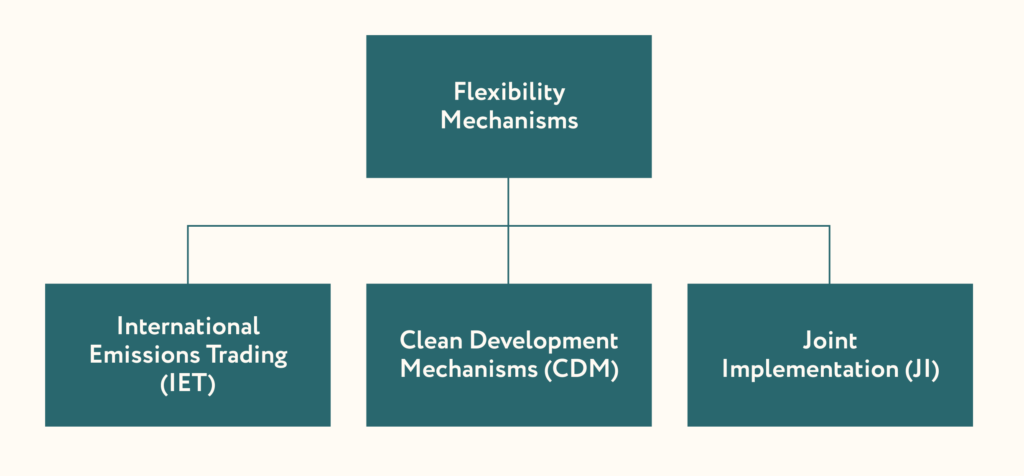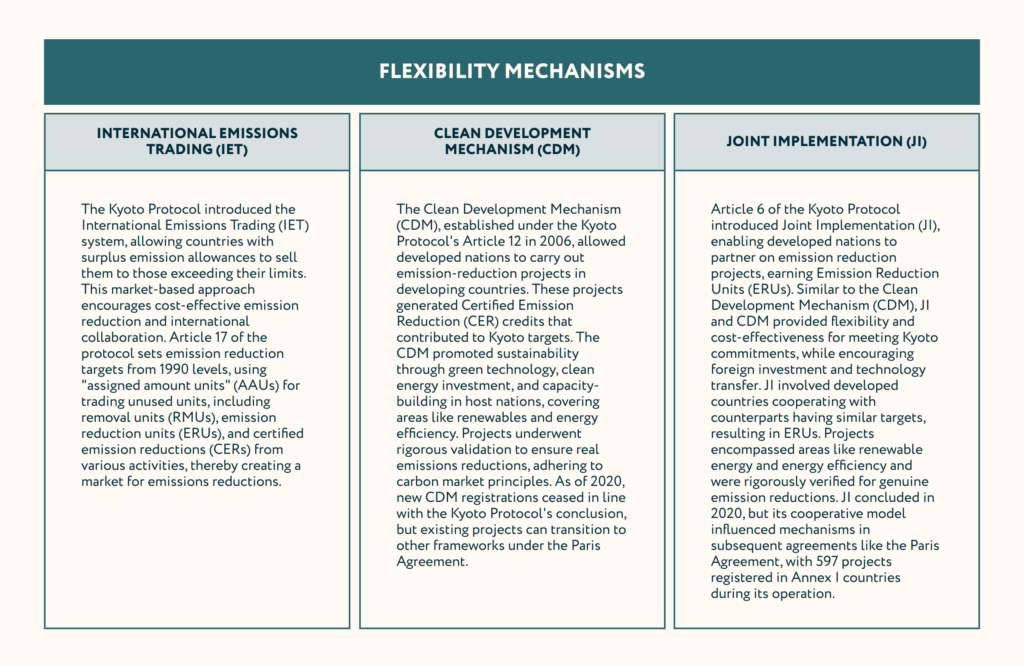OPERATIONALIZING THE COMPLIANCE MARKET
The Kyoto Protocol established mandatory greenhouse gas emission limits per industrialized country, which were derived from the overall target of reducing greenhouse gas emissions by 5% relative to 1990 (the ‘base year’). The aim was to achieve this reduction during the ‘commitment period’, from 2008-2012. It introduced UN market-based mechanisms (also called ‘Flexibility Mechanisms’); such as the International Emissions Trading (ET), the Clean Development Mechanism (CDM) and Joint Implementation (JI) to achieve cost-effective greenhouse gas abatement.
The Protocol had two phases:
- 2008-2012
- 2013-2020 (Doha Amendment)
The Protocol includes in Annex-I a list of industrialized countries, economies in transition, and the European Union that commit to meet the binding emission reduction targets set in Annex B.
As such, the Protocol acknowledges the large responsibility of current high levels of GHG emissions in the atmosphere to the countries listed. However, this created a point of contention during the ratification process as China and India were some of the largest emitters at the time and were not mandated to commit to an emission target.
The Protocol ensured strict oversight through a registry system, consistent reporting, and compliance measures. Moreover, it supports climate adaptation via the “Adaptation Fund,” initially funded by CDM proceeds; subsequently, the Doha Amendment extended its scope to include contributions from JI and ET, offering a 2% share for this purpose.
WHAT IS A FLEXIBILITY MECHANISM?
A Flexibility Mechanism is a market-based approach designed to facilitate the reduction of greenhouse gas emissions and promote sustainable development. It provides flexibility for countries to achieve their emission reduction targets by trading emissions allowances or credits, thus allowing them to cost-effectively meet their commitments. These mechanisms create a market where emissions allowances can be bought and sold, enabling countries that can reduce emissions at a lower cost to do so, while those with higher costs can purchase allowances from others.

Figure 1.2. Flexibility Mechanisms
These mechanisms aim to provide cost-effective ways to achieve emission reduction targets while fostering collaboration, technology transfer, and financial support between nations. They are essential tools in the global effort to mitigate climate change and promote a transition to a low-carbon economy.

LESSONS LEARNED
- Low demand due to lackluster political will
- Information and procedural complexity and opacity
- Low participation from Least Developed Countries (LDC)
- Other incentive issues

Figure 1.3. Kyoto Protocol targets and global emissions (Shishlov et al. 2016)
Low Demand Due to Lackluster Political Will
Low demand, stemming from insufficient political will, was the primary factor hindering the effectiveness of Kyoto’s market mechanisms. These mechanisms rely on incentives, with carbon revenues making projects viable and trading allowing cost-efficient solutions. However, without credible carbon prices, there’s no motivation for projects or trading. The US’s non-ratification of the Kyoto Protocol limited demand, with other nations accounting for just 21% of emissions, and uncertainty about commitments reduced the incentive. Non-binding emission caps and economic factors further weakened commitment. The reliance on the EU ETS, coupled with the financial crisis, led to a collapse in carbon prices and demand. Attempts to adapt the mechanisms couldn’t overcome low political will. Effective carbon markets need strong, consistent demand reflected in meaningful asset prices.
Information and procedural complexity and opacity
The complexity and strictness of the Clean Development Mechanism (CDM) have been criticized. While efforts were made to standardize additionality tests and methodologies for environmental integrity, concerns arose about their subjectivity, unpredictability, and exploitation potential. The tradeoff between integrity and complexity emerged, as complex tests ensured additionality but were expensive to administer. Financial additionality tests required carbon revenue’s decisive influence on project viability. However, banks, the primary financiers, didn’t recognized projected carbon revenue due to market complexity, low demand, and policy uncertainty. Consequently, the development of CDM projects favored those that would occur regardless of carbon revenues.
Joint Implementation (JI) and International Emissions Trading (IET) also faced opacity issues. In JI, AAUs were converted to ERUs and traded through intermediaries, raising transparency concerns. IET displayed AAU trades but lacked transaction details and account holders, making independent monitoring challenging.
Low participation from Least Developed Countries (LDC)
A challenge specific to the Clean Development Mechanism (CDM) was the limited involvement of Least Developed Countries (LDCs). While China and India generated 67% of CERs, Africa, home to most low-income countries, contributed only 5%. This disparity was influenced by high transaction costs and complexity, deterring project developers and host countries. The upfront costs of creating a CDM project were significant, making small-scale projects in LDCs less appealing. Compliance with monitoring, reporting, and verification (MRV), GHG accounting, and institutional standards was demanding for host countries. The emergence of Programmatic CDM (PoA) and the EU’s exclusion of non-LDC CERs from its ETS after 2013 encouraged LDC participation, but the absence of a second Kyoto commitment period impacted the growth of LDC CERs.
Other Incentive Issues
Apart from low demand and political will affecting carbon asset prices, other fixable issues impacted incentives.
Despite potential access to emissions from non-mitigating countries, gaps remained in Kyoto mechanisms. In sectors like forestry, carbon sequestration incentives were lacking, with up to 88% unstimulated. Emissions reductions in transportation, carbon capture, nuclear energy, and sustainable development were also insufficiently incentivized due to political decisions, risk perception, and pricing.
Though sustainable development was an official goal, few projects received price premiums for higher sustainable development benefits. The mechanisms lacked incentives for broader emissions coverage or enhanced sustainable development.
Moreover, some provided incentives were counterproductive. Governments selling excess allowances (AAUs) or converting them to project-based credits (ERUs) risked undermining system integrity and fostering collusion. Intermediaries arbitraging between market and government allowance prices created incentives for obtaining allowances well below market rates.
This information has been acquired from the “World Bank. 2018. Carbon Markets Under the Kyoto Protocol: Lessons Learned for Building an International Carbon Market Under the Paris Agreement. © World Bank, Washington, DC. http://hdl.handle.net/10986/31210 License: CC BY 3.0 IGO.”
